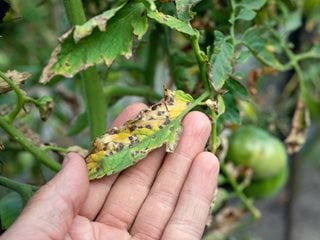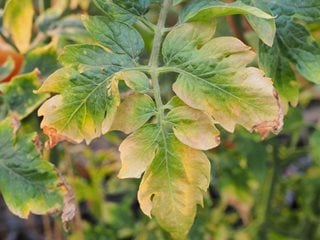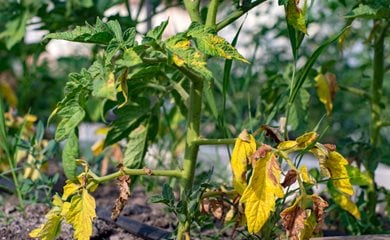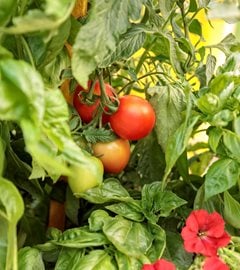Why Are My Tomato Plant Leaves Turning Yellow?
Find out what causes yellow leaves on tomato plants and how to solve the problem Reviewed by Denise Kelly, HorticulturistWhether you're just starting out with vegetable gardening or consider yourself a pro, you may have encountered a nagging problem when growing tomatoes. Why are your tomato plant leaves turning yellow?
Start by figuring out whether the yellow leaves indicate a larger problem. In certain cases yellow tomato leaves can be normal, here are two examples:
- If the bottom leaves on your tomato plants are yellow, these are likely the seedling leaves which will eventually fall off. The next leaves up have more cause for concern if you see a yellowish tint.
- One of the first signs of transplant shock is yellowing leaves. To prevent this, transplant seedlings once they are 3-4 inches tall or at least two weeks after sowing the seeds. A process called hardening off can also help acclimate them to their new spot.
1. WATERING ISSUES CAUSE YELLOW TOMATO LEAVES
How much you water your tomatoes can affect their growth. If you water by hand, pay close attention to the leaves — if they start turning yellow assess your watering habits.
Too much water is a common problem that can lead to root rot. Too little water can also cause problems for tomatoes. Before the yellow leaves stand out due to incorrect watering, you may notice wilting and brown edges.
Here are some tomato watering tips:
- When you first plant tomato seeds, only water the soil when the surface is dry. You could get by with a simple spray bottle in early days.
- Once you transplant your tomato plants into the garden, keep a consistent watering schedule.
- Use deep watering techniques throughout the week, especially when the temperatures get warmer!
- Tomatoes in containers dry out faster and need extra watering. Some container tomato plants will need water twice a day.
- Always water at the base of the plant. Watering from above increases the chances of sun damage and disease.
Drip irrigation for tomatoes
Consider installing a drip irrigation system in an outdoor garden to deliver water more efficiently to the plant roots. Drip irrigation systems are 90% efficient, compared to only 65% to 75% efficiency with sprinkler systems. Using drip irrigation also reduces the likelihood of tomato diseases.
If you don't want to purchase a drip irrigation system, pay more attention to the weather in your region. Avoid watering after a rainstorm and consider increasing watering with scorching temperatures.
2. TOMATO DISEASES MAY BE TO BLAME
Poorly drained soils put your plants at risk of various diseases, and by the time you notice, there isn’t much you can do. That’s why prevention tactics are vital to avoiding diseases that can harm your tomato leaves.

A tomato with Septoria leaf spot. Olya Maximenko / Shutterstock
Here are some common tomato plant diseases you will need to watch out for:
- Bacterial wilt
- Early blight
- Late blight
- Septoria Leaf Spot
- Leaf mold
- Tomato Pith Necrosis
- Fusarium wilt
- Verticillium wilt
- Yellow Leaf Curl virus
Most plant diseases require specific instructions on prevention and care. In many scenarios, you will want to remove the diseased portion. For example, tomato blight is a common disease that requires:
- Removal
- Fungicide use
- Mulch
Using fungicide and mulch after removing the diseased portion helps prevent the spread of tomato blight. To prevent future outbreaks, consider crop rotation, circulation, and compost. Avoiding overhead watering on leaves can also reduce leaf fungal diseases.
Tempting Tomatoes®
One of the easiest ways to ensure healthy plants is to grow disease-resistant varieties, such as:
3. A NUTRIENT DEFICIENCY CAN TURN TOMATO LEAVES YELLOW

This tomato is suffering from a lack of nitrogen. walkerone / Shutterstock
Another cause of yellow leaves on tomato plants is nutritional deficiencies. Tomatoes need several nutrients from the soil, including:
- Nitrogen
- Phosphorus
- Potassium
- Sulfur
- Magnesium
- Zinc
- Calcium
- Copper
- Iron
Fertilizing tomato plants
Two of the primary ingredients in fertilizer include nitrogen and potassium. A lack of these nutrients leads to yellowing leaves, referred to as chlorosis.
Pay attention to the fertilizer you use and consider switching to organic fertilizer for better results and improved soil health. Also, look at a fertilizer's micronutrients like calcium, magnesium, and copper. These small changes can help prevent many causes of yellowing leaves.
Pro tip: Epsom salts can be used to treat yellowing leaves caused by magnesium deficiency.
How often will you need to fertilize? Young tomatoes will need fertilization every two weeks before you can start cutting back. If you have tomatoes in containers, you may need to fertilize them every two to four weeks. As always, make sure the plants are well watered before and after fertilizing.
For the best results in your garden, consider having your soil tested. Testing soil can pinpoint the fertilizer type and nutrients your tomato garden needs most.
4. PESTS STRESSED YOUR TOMATO PLANTS
Mites and aphids are two common predators that place added stress and damage on the plant, causing yellowing leaves as one result. You may also see curling leaf tips. Most tomato pests are managed with healthy soil, proper planting techniques, and crop rotation.
If you deal with aphids in your garden, consider using organic sprays or natural predators. Clean out the dead plant material and use a variety of tomato companion plants in your garden that repel aphids, such as catnip, garlic, or chives.
5. FROST DAMAGED THE TOMATO LEAVES
Frost damage on tomatoes can harm the leaves in a few ways. You may notice yellowing, wilting, spots between leaf veins, or blackened leaves. If the frost was mild and the plant’s stem is still healthy, you can simply remove the damaged leaves and let the plant recover.
Pro tip: Protect young tomatoes from unexpected cold weather by covering them with plastic sheeting, a tarp, or fabric.
KEEPING YOUR TOMATO LEAVES HEALTHY & GREEN
Tomato plant leaves turning yellow can wreck your harvest and ruin that yummy salsa recipe you had in store. Instead, keeping close tabs on your tomato leaves can help you catch problems early on and save your tomatoes.
Proper watering, drainage, and nutrients are essential to a healthy garden. Keep your schedule consistent and consider spacing out your plants and offering enough shade if you live in a hot region.
More on growing tomatoes:
Best Types of Tomatoes
Tomato Leaves Curling
Staking Tomatoes
Tomato Gardening Tips
RELATED:
Powdery Mildew
Garden-to-Table Recipes


